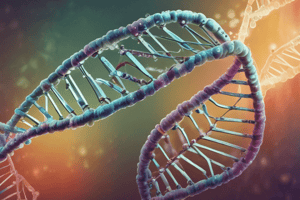Podcast
Questions and Answers
Who made significant contributions to the understanding of the helical structure of DNA?
Who made significant contributions to the understanding of the helical structure of DNA?
- Linus Pauling and Jerry Donohue
- Rosalind Franklin, Gosling, and Maurice Wilkins (correct)
- John Griffith and Erwin Chargaff
- James Watson and Francis Crick
What was a critical aspect of DNA pairing discovered by John Griffith?
What was a critical aspect of DNA pairing discovered by John Griffith?
- A always pairs with C and T with G.
- Triple helix structure of DNA.
- Nucleotides are flat and stack atop one another. (correct)
- The sugar-phosphate backbone is on the outside.
Which aspect of Erwin Chargaff's rule relates to DNA structure?
Which aspect of Erwin Chargaff's rule relates to DNA structure?
- Phosphate groups are responsible for helical formation.
- Nucleotides bond only through hydrogen bonds.
- Purine-pyrimidine ratio is 1:1. (correct)
- Sugar molecules alternate positions in the double helix.
Which of the following individuals was not awarded the Nobel Prize for the DNA structure in 1962?
Which of the following individuals was not awarded the Nobel Prize for the DNA structure in 1962?
What publication did Watson and Crick release regarding DNA in April 1953?
What publication did Watson and Crick release regarding DNA in April 1953?
Who discovered DNA while characterizing proteins from pus cells?
Who discovered DNA while characterizing proteins from pus cells?
What did Frederick Griffith's transformation experiment demonstrate?
What did Frederick Griffith's transformation experiment demonstrate?
What did Oswald Avery and his colleagues identify as the transforming principle?
What did Oswald Avery and his colleagues identify as the transforming principle?
Which experiment did Alfred Hershey and Martha Chase conduct to prove DNA is the genetic material?
Which experiment did Alfred Hershey and Martha Chase conduct to prove DNA is the genetic material?
Which researchers are credited with discovering the structure of DNA?
Which researchers are credited with discovering the structure of DNA?
In what year did Frederik Griffith perform his key transformation experiment?
In what year did Frederik Griffith perform his key transformation experiment?
Which scientist used a staining technique to observe that DNA is a crucial nuclear element?
Which scientist used a staining technique to observe that DNA is a crucial nuclear element?
Which experiment by Zinder and Lederberg contributed further proof that DNA is the genetic material?
Which experiment by Zinder and Lederberg contributed further proof that DNA is the genetic material?
Flashcards are hidden until you start studying
Study Notes
Key Contributors to DNA Structure Discovery
- Rosalind Franklin, Gosling, and Maurice Wilkins identified DNA's helical structure, positioning of sugars and phosphates on the exterior, with nucleotides situated inside.
- James Watson and Francis Crick proposed a triple-helix model but later corrected their model to a double helix with complementary base pairing.
- Linus Pauling suggested a triple helix model but was later outweighed by Watson and Crick's findings.
Influential Researchers in DNA Molecular Configuration
- John Griffith established that nucleotides stack flatly; noted adenine pairs with thymine and cytosine pairs with guanine, crucial for DNA replication.
- Erwin Chargaff observed a consistent purine-pyrimidine ratio (1:1) which became known as Chargaff's rule.
- Jerry Donohue discovered that hydrogen positions in nitrogenous bases can shift, affecting hydrogen bonding.
Watson and Crick's Publications
- "Molecular Structure of Nucleic Acid" published in April 1953 in Nature (Volume 171: 737-738).
- "Genetic Implications of the Structure of Deoxyribonucleic Acid" published in May 1953 in Nature (Volume 171: 964-967).
Nobel Prize Recognition
- James Watson, Francis Crick, and Maurice Wilkins received the Nobel Prize in 1962 for their work on DNA's structure, with Rosalind Franklin omitted due to her passing in 1958.
Historical Milestones in DNA Research
- 1830: Proteins were deemed the most crucial biological molecules.
- Late 1860s: Friedrich Miescher isolated a distinct molecule from the nucleus (DNA); salmon sperm DNA’s empirical formula identified as $C_{29}H_{49}N_9P_3O_{22}$.
- 1866: Ernst Haeckel recognized the nucleus as a major cellular component, while Edmund Wilson concluded DNA was the primary nuclear element passed through generations.
- 1928: Frederick Griffith demonstrated the "transforming principle" using Streptococcus pneumoniae to prove the existence of genetic material.
- 1944: Oswald Avery, Colin Macleod, and Maclyn McCarty determined that the transforming principle was DNA through experiments involving degradation by proteins and RNAs versus DNAs.
- 1952: Alfred Hershey and Martha Chase confirmed that DNA is the genetic material of viruses through their blender experiment, distinguishing DNA from protein components.
- 1952: Norton Zinder, Joshua, and Esther Lederberg reinforced that DNA acts as genetic material via transduction experiments in Salmonella typhimurium.
- 1953: Formation of the DNA double helix model attributed to Franklin, Wilkins, Watson, and Crick.
Key Background Information
- Francis Crick earned a Ph.D. in biophysics, starting protein x-ray studies in 1947 at Cambridge.
- James Watson attained a Ph.D. in microbiology from the University of Indiana, transferring to Cambridge in 1951.
- Maurice Wilkins, with a Ph.D. in physics, contributed to radar and the Manhattan Project, serving as assistant director of medical research at King's College London.
Studying That Suits You
Use AI to generate personalized quizzes and flashcards to suit your learning preferences.




